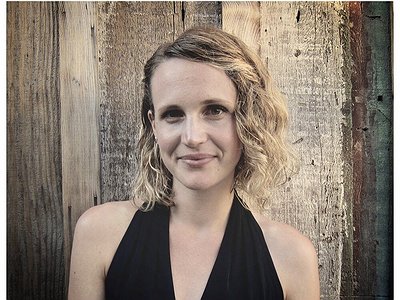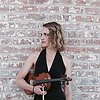Part 1
Name: Ariel Marx
Nationality: American
Occupation: Composer (film, TV, multimedia)
Current release: To Dust by Shawn Snyder | The Tale (HBO) by Jennifer Fox
Recommendations: A Humument by Tom Phillips | Summa for String Orchestra, Arvo Pärt
Website / Contact: If you enjoyed this interview with Ariel Marx visit her website www.arielmarx.com
When did you start composing film music - and what or who were your early passions and influences? What is it about music and/or sound that drew you to it?
I started composing music for visual media, officially, around 7 years ago. However, my compositions have always had a narrative, audio-visual aspect to them — be it composing music for shadowbox displays, or inspired by a painting etc. I always felt more connected to a piece of music that I was writing when it had a greater, collaborative purpose. I love the creative back-and-forth and constant re-evaluation and growth required in writing music for film. Being given certain aesthetic parameters and narrative tasks makes me evolve differently as a composer with every project.
For most artists, originality is first preceded by a phase of learning and, often, emulating others. What was this like for you? How would you describe your own development as an artist and the transition towards your own voice? What is the relationship between copying, learning and your own creativity?
Finding your own voice is often a product of doing what others have done, and making conscious choices to differentiate. When you study composition and orchestration, you learn about techniques that are guaranteed to work, tried-and-true. You learn about creating strong melodies and clear, well-balanced orchestrations. However, when you enter the world of the film (or TV or any other visual media), a unique, multifaceted aesthetic takes over — and it’s the musical wild west. Each film has its own voice, and character, and it’s your job as the composer to support that. This collaboration and specific challenge with each film has allowed me to explore not only different and singular live ensembles, but to refine and master the use of sample libraries, synths, live players, creative mixing techniques, and my own performance to create my own voice, and thus a unique voice to the film.
I am a multi-instrumentalist and play on nearly every score I write, so my “voice” is literally inextricable from the music. It’s important for me at the beginning of each new project to create entirely different sonic templates from the previous project. New aural aesthetics as well as narrative ones push me to constantly refine and define my own voice and, in turn, create a voice for the film itself.
What were your main compositional challenges when starting out as a film composer and how have they changed over time?
I think the biggest challenge is very often the quicker-than-preferred turnaround. I’ve learned to be very nimble on my feet. This takes a lot of preparation, of course. The most important thing is to have a studio that’s conducive to allowing you to capture your creativity — for me this means having well-organized templates that allow me to access all of my sound libraries and synths immediately, and to have my live instruments and microphones within arm’s reach.
What, to you, are the main functions and goals of soundtracks and film music and how would you rate their importance for the movie as a whole? How do you maintain a balance between, on the one hand, artistic integrity and sticking to your creative convictions and, on the other, meeting the expectations of the director?
I think the score should always have an additional commentary on the narrative, and — to me — is vital to voice of the film. In reductive terms, this can mean either re-enforcing or challenging the tone of the film, and all the grey areas in between. With the director, you make a choice as to how it will function — will it deepen and broaden the emotion already exhibited on screen, or will nod to something quite different?
In regards to maintaining artistic integrity — ultimately, it is the composer’s challenge to grow and adjust to the parameters and needs of the film, while always maintaining their voice. Sometimes these two things may be at odds with one another, but there are always creative solutions. Often times the solution will be much less drastic than expected — an altered arrangement, a change of a melody note. Sometimes, a re-write is in order. Ultimately, this is the beauty and the challenge of the collaboration — you arrive at something neither director nor composer could have on their own.
What was your first studio like? How and for what reasons has your set-up evolved over the years and what are currently some of the most important pieces of gear for you?
In addition to having top-of-the-line speakers, audio interfaces, sample libraries, and plugins, the most important modifications I have made to my studio are related to making sure I have quick access to everything I need so I can start creating immediately. My instruments are all around me, and my microphones are set up and placed — ready to be used.
How do you make use of technology? In terms of the feedback mechanism between technology and creativity, what do humans excel at, what do machines excel at?
In my opinion, it is impossible to be a media composer without being a master of technology. My DAW, synths, sample libraries, plugins, and other software and hardware are no different than my violin and bow — they are critical to my composition process. The current standards of production quality for composers are very high — we have to be composers, performers, orchestrators, score producers, mixing engineers, and music editors in one. Beyond necessity, I use technology to my creative advantage — I often process acoustic recordings with multiple plugins and effects to create unexpected colors and nuance; I combine organic/acoustic sounds with electronics, I create my own sample libraries; much of my creative voice is expressed through this relationship with technology.
Production tools, from instruments to complex software environments, contribute to the compositional process. How does this manifest itself in your work? Can you describe the co-authorship between yourself and your tools?
To me, they are one and the same — my tools are an extension of my creativity; we are a single instrument with unlimited sounds, articulations, and timbres. To give a small example from a recent score, I recorded several long-bowed techniques on my violin and layered them, panning them widely left and right to create a wide stereo image. I then added multiple plugins — stereo delays, filters, distortion, and warped reverb. I then did this several more times at different intervals and dynamics. I then printed this “instrument” and mapped it to my Kontakt player. Now, I have this hybrid “instrument” at my disposal at several octaves and can even adjust the performance with continuous controllers. I can also add additional midi FX (arpeggiators, modulators etc), audio FX, and automation to create an even more nuanced sound. This hybrid instrument is a perfect example of the value of using technology to your greatest advantage to create libraries that only you have.






